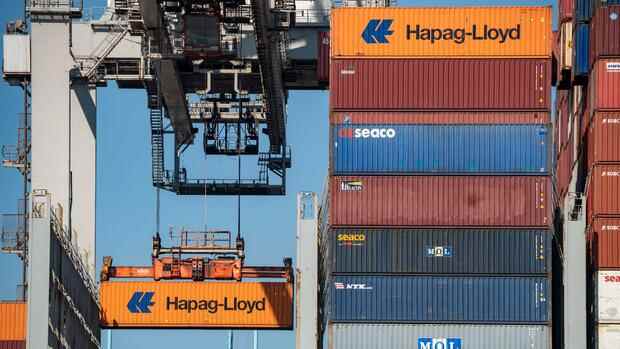Hapag-Lloyd wants to equip all of its own containers with sensors.
(Photo: IMAGO/Jochen Tack)
Dusseldorf Hamburg-based Hapag-Lloyd will be the first shipping company in the world to equip its entire inventory of containers with data transmitters in order to identify delivery disruptions at an early stage. By the end of 2023 at the latest, all three million standard containers (TEU) should report their movement data, but also information about vibrations or temperature fluctuations to the head office via the cloud.
According to the Swiss supplier Nexxiot, the equipment with the solar-powered data boxes, which transmit their information via mobile communications, costs around 1,000 euros per container. “Many customers are willing to pay a surcharge,” says Hapag-Lloyd manager Olaf Habert in an interview with Handelsblatt. Discussions with the industry showed that.
Hapag also wants to use the data for other business models. “With eleven million transports a year, we cover a fairly large part of the transport infrastructure,” says Habert. “And we can certainly draw interesting conclusions from our data.”
The investment decision was preceded by a three-year test phase with refrigerated containers, with results that should now help with the roll-out. In an interview, Habert explains what is already working smoothly – and what plans there are.
Top jobs of the day
Find the best jobs now and
be notified by email.
Read the full interview here:
Mr. Habert, three years ago, Hapag-Lloyd equipped the first refrigerated containers with sensor boxes that regularly transmit data to the headquarters. Are there any first successes?
There was a spectacular case recently in Chile. We made one of these containers available to customers there, which they had loaded with freshly harvested cherries. Halfway between the farm and the port, the truck was attacked and stolen. The fact that the thieves switched off the GPS transmitter on the vehicle didn’t help them much in the end. Using the tracking device in the container, we were able to locate the gang five kilometers away from the farm, where they were just sampling the first cherries when the police arrived.
Now you want to equip all three million standard containers of your shipping company with cellphone-capable tracking devices. To know where your containers are?
We already know that today – but only with large gaps. Above all, we want to make visible in real time what is happening to the container on trucks and rails in the hinterland. This transparency is important to our customers in order to optimize their own processes. Internally, we also find out which container is empty and has been lying around at the customer’s for days.
The manager is Director Container Applications at Hapag-Lloyd.
(Photo: Hapag-Lloyd)
In the future, the containers will even report regularly via mobile communications from the sea. Does that work at all without transmission masts?
In the future we want to have local cell phone networks on board like on cruise ships. Then we can send the data to the cloud via satellite, but we’re still working on it. However, we and our customers are primarily interested in what happens to the containers on land. Because when he’s on board, it’s statistically the safest place in the world for him. In order to create a comprehensive network at sea, we need a common industry standard. It may take three to five years to get there.
Will the shipping companies in THE Alliance with which you share the routes join your model?
That would definitely be the first step. But we are also discussing which technology is the best solution with other large shipping companies such as Maersk, CMA CGM and MSC. If we rely on LTE, but competitors use a different standard, the entire system at sea only works incompletely.
We assume that we will remain the only ones with this for at least a year. Hapag-Lloyd manager Olaf Habert
The tracking devices on standard containers are powered by sunlight. But that is not the case for most containers on board.
Which is not a problem for us. The devices can transmit actively for 90 days without being charged. Our longest sea voyage lasts only 40 to 42 days.
According to the manufacturer, the equipment should cost around 1,000 euros per container. Do your customers pay a surcharge?
In preliminary talks with the industry, we learned that yes, many are willing to pay a surcharge. The first bookings of these equipped standard containers will be available from the beginning of next year. In the future, additional sensors can be connected to the device via a Bluetooth interface, which can measure the temperature, vibrations or humidity in the interior, for example, which brings additional advantages when planning product packaging.
>> Read also: Fighting supply chain problems: Logisticians buy data hunters
Who owns the data?
Us. After all, the containers belong to Hapag-Lloyd and we are responsible for their operation. Data ownership is very important to us.
Do you use the data – for example in an anonymous form – for other business models?
That’s one of the ideas for the future that we have. With eleven million transports a year, we cover a fairly large part of the transport infrastructure. And there are certainly interesting conclusions to be drawn from our data.
How long do you think Hapag-Lloyd will remain the only container shipping company with such a system?
Because we know how long gearing like this takes, we expect to be the only ones for at least a year, ideally two.
Mr. Habert, thank you very much for the interview.
More: Shipping companies invest billions in acquisitions from the logistics industry
